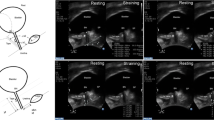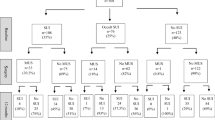Abstract
Introduction and hypothesis
Midurethral sling (MUS) is now the first line surgical treatment for female stress urinary incontinence. Our aim was to identify predictors for MUS failure.
Methods
A total of 1,225 consecutive women with urodynamic urinary stress incontinence had a synthetic MUS (955 retropubic and 270 transobturator) at our institution between 1999 and 2007. Multivariate analysis was performed in order to identify independent risk factors for failure.
Results and conclusions
At a mean follow-up of 50 ± 24 months (range, 12–114), the subjective cure rate was 84.7%. Multivariate analysis revealed that BMI >25 (OR, 2.9), mixed incontinence (OR, 2.4), previous continence surgery (OR, 2.2), intrinsic sphincter deficiency (OR, 1.9), and diabetes mellitus (OR, 1.8) are significant independent predictors for MUS failure. Concomitant prolapse surgery decreased the likelihood of surgical failure after MUS (OR, 0.6). Patient’s age and the type of the sling were not found to be risk factors for surgical failure.

Similar content being viewed by others
References
Ulmsten U, Petros P (1995) Intravaginal slingplasty (IVS): an ambulatory surgical procedure for treatment of female urinary incontinence. Scand J Urol Nephrol 29:75–82
Bemelmans BL, Chapple CR (2003) Are slings now the gold standard treatment for the management of female urinary stress incontinence and if so which technique? Curr Opin Urol 13:301–307
Delorme E (2001) Transobturator urethral suspension: mini-invasive procedure in the treatment of stress urinary incontinence in women. Prog Urol 11:1306–1313
Liapis A, Bakas P, Creatsas G (2008) Long-term efficacy of tension-free vaginal tape in the management of stress urinary incontinence in women: efficacy at 5- and 7-year follow-up. Int Urogynecol J Pelvic Floor Dysfunct 9:1509–1512
Abrams P, Cardozo L, Fall M et al (2002) The standardisation of terminology of lower urinary tract function: report from standardisation subcommittee of international continence society. Neurorol Urodyn 21:167–178
Lose G, Griffiths D, Hosker G et al (2002) Standardisation of urethral pressure measurement: report from the Standardisation Sub-Committee of the International Continence Society. Neurourol Urodyn 21:258–260
Lose G (1997) Urethral pressure measurement. Acta Obstet Gynecol Scand Suppl 166:39–42
Ulmsten U (2001) An introduction to tension-free vaginal tape (TVT)—a new surgical procedure for treatment of female urinary incontinence. Int Urogynecol J Pelvic Floor Dysfunct 12:3–4
Charalambous S, Touloupidis S, Fatles G et al (2008) Transvaginal vs transobturator approach for synthetic sling placement in patients with stress urinary incontinence. Int Urogynecol J Pelvic Floor Dysfunct 19:357–360
Shumaker SA, Wyman JF, Uebersax JS et al (1994) Health-related quality of life measures for women with urinary incontinence: the incontinence impact questionnaire and the urogenital distress inventory. Continence Program in Women (CPW) research group. Qual Life Res 3:291–306
Barber MD, Walters MD, Bump RC (2005) Short forms of two condition-specific quality-of-life questionnaires for women with pelvic floor disorders (PFDI-20 and PFIQ-7). Am J Obstet Gynecol 193:103–113
Rogers RG, Coates KW, Kammerer-Doak D et al (2003) A short form of the Pelvic Organ Prolapse/Urinary Incontinence Sexual Questionnaire (PISQ-12). Int Urogynecol J Pelvic Floor Dysfunct 14:164–168
Koops SE, Bisseling TM, van Brummen HJ et al (2006) What determines a successful tension-free vaginal tape? A prospective multicenter cohort study: results from the Netherlands TVT database. Am J Obstet Gynecol 194:65–74
Lee KS, Choo MS, Doo CK et al (2008) The long term (5-years) objective TVT success rate does not depend on predictive factors at multivariate analysis: a multicentre retrospective study. Eur Urol 53:176–182
Chen HY, Yeh LS, Chang WC et al (2007) Analysis of risk factors associated with surgical failure of inside-out transobturator vaginal tape for treating urodynamic stress incontinence. Int Urogynecol J Pelvic Floor Dysfunct 18:443–447
Cetinel B, Demirkesen O, Onal B et al (2004) Are there any factors predicting the cure and complication rates of tension-free vaginal tape? Int Urogynecol J Pelvic Floor Dysfunct 15:188–193
Paick JS, Cho MC, Oh SJ et al (2007) Factors influencing the outcome of mid urethral sling procedures for female urinary incontinence. J Urol 178:985–989
Paick JS, Oh SJ, Kim SW et al (2008) Tension-free vaginal tape, suprapubic arc sling, and transobturator tape in the treatment of mixed urinary incontinence in women. Int Urogynecol J Pelvic Floor Dysfunct 19:123–129
Barber MD, Kleeman S, Karram MM et al (2008) Risk factors associated with failure 1 year after retropubic or transobturator midurethral slings. Am J Obstet Gynecol 199(666):e1–7
Anger JT, Litwin MS, Wang Q et al (2008) The effect of concomitant prolapse repair on sling outcomes. J Urol 180:1003–1006
Yip SK, Pang MW (2006) Tension-free vaginal tape sling procedure for the treatment of stress urinary incontinence in Hong Kong women with and without pelvic organ prolapse: 1-year outcome study. Hong Kong Med J 12:15–20
Rafii A, Paoletti X, Haab F et al (2004) Tension-free vaginal tape and associated procedures: a case control study. Eur Urol 45:356–361
Hellberg D, Holmgren C, Lanner C et al (2007) The very obese woman and the very old woman: tension-free vaginal tape for the treatment of stress urinary incontinence. Int Urogynecol J Pelvic Floor Dysfunct 18:423–429
Kulseng-Hanssen S, Husby H, Schiotz HA (2007) The tension free vaginal tape operation for women with mixed incontinence: do preoperative variables predict the outcome? Neurourol Urodyn 26:115–121
Holmgren C, Nilsson S, Lanner L et al (2005) Long-term results with tension-free vaginal tape on mixed and stress urinary incontinence. Obstet Gynecol 106:38–43
Meschia M, Pifarotti P, Gattei U et al (2007) Tension-free vaginal tape: analysis of risk factors for failures. Int Urogynecol J Pelvic Floor Dysfunct 18:419–422
Meschia M, Pifarotti P, Buonaguidi A et al (2005) Tension-free vaginal tape (TVT) for treatment of stress urinary incontinence in women with low-pressure urethra. Eur J Obstet Gynecol Reprod Biol 122:118–121
Paick JS, Ku JH, Shin JW et al (2004) Tension-free vaginal tape procedure for urinary incontinence with low Valsalva leak point pressure. J Urol 172:1370–1373
Daneshgari F, Moore C, Frinjari H et al (2006) Patient related risk factors for recurrent stress urinary incontinence surgery in women treated at a tertiary care center. J Urol 176:1493–1499
Conflicts of interest
None.
Author information
Authors and Affiliations
Corresponding author
Appendix
Appendix
Rights and permissions
About this article
Cite this article
Stav, K., Dwyer, P.L., Rosamilia, A. et al. Risk factors of treatment failure of midurethral sling procedures for women with urinary stress incontinence. Int Urogynecol J 21, 149–155 (2010). https://doi.org/10.1007/s00192-009-1020-9
Received:
Accepted:
Published:
Issue Date:
DOI: https://doi.org/10.1007/s00192-009-1020-9




